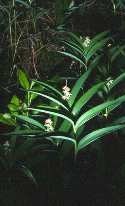









|
|
The Foothills Parkland Vegetation
The Foothills Parkland Subregion forms a narrow, transitional band between the grasslands of the Foothills Fescue Subregion and the forests of the
Montane Subregion. As in the Central Parkland
Subregion, there is a continuum from grassland with groves, to forest with grassy parks, to closed
deciduous forest. Because of rapid topographic and climatic change, the transition occurs over distances as small as one kilometre and rarely over more than five kilometres. This compression of the vegetational continuum results in small geographic areas being very diverse.
 Desiccation by wind and low precipitation
appear to be the main factors determining the extent of this subregion. The northern boundary of this subregion has been placed near Calgary since this is apparently about the limit of a number of distinctive southwestem species. This is the most northerly place where
lupines, oatgrass, and Idaho fescue
Desiccation by wind and low precipitation
appear to be the main factors determining the extent of this subregion. The northern boundary of this subregion has been placed near Calgary since this is apparently about the limit of a number of distinctive southwestem species. This is the most northerly place where
lupines, oatgrass, and Idaho fescue occur commonly. However, the majority of southwestern
species do not occur north of the Whaleback-Porcupine Hills area. Central Parkland species conspicuously absent here include
beaked hazel, highbush cranberry, sarsaparilla, bunchberry, and wild
lily-of-the-valley. occur commonly. However, the majority of southwestern
species do not occur north of the Whaleback-Porcupine Hills area. Central Parkland species conspicuously absent here include
beaked hazel, highbush cranberry, sarsaparilla, bunchberry, and wild
lily-of-the-valley.
The grassland of the Foothills Parkland Subregion is the same as in the Foothills Fescue Subregion,
with a diverse arrangement of forb and grass species. There are also little-known communities on outwash terraces of major streams that are dominated by
little bluestem.
 Aspen is generally dominant in the upland forests with balsam poplar occurring on moister sites. Common understory species include
snowberry, saskatoon, white meadowsweet, cream-coloured peavine,
strawberry, leafy aster, western meadow rue, Canada violet,
star-flowered Solomon's seal, cow parsnip, yellow angelica, and white
geranium. A distinctive characteristic of these woods in the southwestern part of the subregion is large amounts of
glacier lily which bloom in early to mid-May. Aspen is generally dominant in the upland forests with balsam poplar occurring on moister sites. Common understory species include
snowberry, saskatoon, white meadowsweet, cream-coloured peavine,
strawberry, leafy aster, western meadow rue, Canada violet,
star-flowered Solomon's seal, cow parsnip, yellow angelica, and white
geranium. A distinctive characteristic of these woods in the southwestern part of the subregion is large amounts of
glacier lily which bloom in early to mid-May.
 Willow groveland dominated by Bebb's willow occurs extensively on fine-textured
glaciolacustrine material and on imperfectly to poorly-drained morainal sites. This distinctive community occurs mainly in the northern part of the subregion. Understory species include
squaw root, Canada anemone, tall larkspur and white geranium.
Narrow-leaved cottonwood forests occur on shifting fluvial terrace deposits in the southern part of the
subregion as well.
Willow groveland dominated by Bebb's willow occurs extensively on fine-textured
glaciolacustrine material and on imperfectly to poorly-drained morainal sites. This distinctive community occurs mainly in the northern part of the subregion. Understory species include
squaw root, Canada anemone, tall larkspur and white geranium.
Narrow-leaved cottonwood forests occur on shifting fluvial terrace deposits in the southern part of the
subregion as well.
Information provided by and printed with the permission
of Alberta Community Development, Provincial
Parks and Protected Areas.
[Geology
and Landforms][Climate][Soils]
[Vegetation][Wildlife]
|















